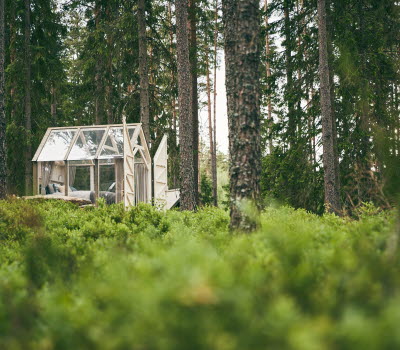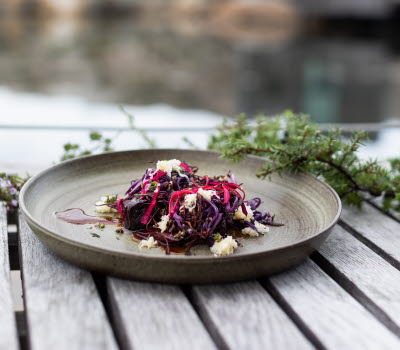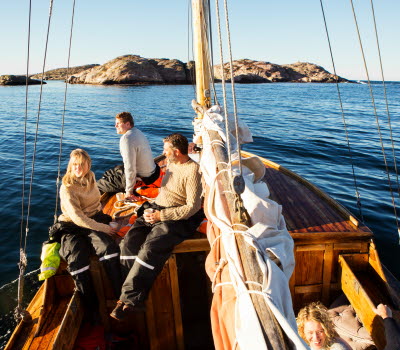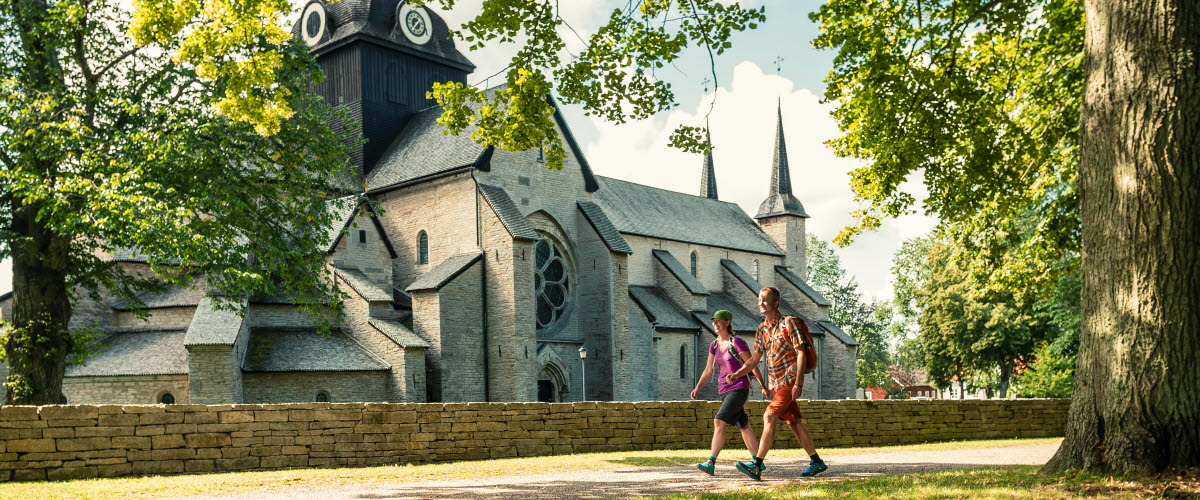Pilgrim Path Falköping-Varnhem – A walk through history
The picturesque Pilgrim Path between Falköping and Varnhem in Skaraborg offers lovely walking through beautiful natural surroundings. Enjoy exploring the rolling countryside between a couple of table mountains, two medieval abbey ruins and the rich birdlife of Lake Hornborga.
Facts about the trail
Length: The trail is approximately 44 kilometres
Timing: Around 14.5 hours non-stop, just enough for three day stages.
Difficulty: Easy to moderate with some hilly sections.
Terrain: Surfaces vary from narrow forest paths and grazing land to gravel roads. Some parts go along asphalt roads with relatively little traffic and through urban areas.
Waymarking: Classic pilgrimage waymarking in the form of a red St Olof’s sign.
Clothes and equipment: Good walking shoes, rucksack with food, water bottle and clothes suitable for the weather. If walking longer than one day you’ll need a change of clothes and accommodation plans.
Insta-moments: Varnhem Abbey Church is one of West Sweden’s most beautiful churches.
The Pilgrim Path takes you from Falköping to Varnhem, a 44 kilometre stretch which is easy to divide up into a few day stages. It’s a hiking trail with a major historical connection to the pilgrimage phenomenon, not least through the two abbey ruins along the way, in Gudhem and Varnhem.
There’s a lot to discover along the trail, including one of Europe’s most significant waterbird sites, two majestic table mountains, Mösseberg and Billingen, and lots of lovely places for relaxing fikas and accommodation. You can read more about the highlights of the walk below.
Photographer: Jonas Ingman
10 places to see along the Pilgrim Path Falköping-Varnhem
1. Falköping and St Olofs Church
The start of the Pilgrim Path is by St Olofs church in Falköping. The oldest part of the church dates back to the 1100s and has withstood several of the fires that destroyed the town’s wooden buildings. From the church you’ll walk through the pretty town centre with nice independent shops, cafes and restaurants.
Make sure you allow yourself time to visit some of Falköping’s most popular destinations. Falbygdens museum, with interesting history exhibitions, is a great stop, and Falbygdens Osteria complete with cheese shop and restaurant is just a short detour from the trail.
Falbygdens museum
Falbygdens Osteria
2. Mösseberg
As you walk out of Falköping you’ll get acquainted with Mösseberg plateau mountain. The path goes up the mountain through Mösseberg Park where you’ll pass the popular spa hotel Mössebergs Kurort.
Also up on the mountain is Mössebergs Djurpark, a zoo with peacocks, pigs, donkeys and other animals. If you want to raise your heart rate a bit more you can walk the 200 steps up to the top of the 35 metre high observation tower. On a clear day there’s a perfect view of large parts of Skaraborg and you can see several of the other mountains that are part of the Platåbergens Geopark. Both the zoo and the tower have free entry.
Photographer: Falköpings kommun
3. Kdesign
In the countryside around Falköping there are many charming farm cafes and design shops. One of these is Kdesign which you’ll get to about one kilometre past Östra Tunhem church. You can shop for interior décor, pottery and cushions here – or just slink in for a fika or quick lunch.
Hint! When you pass Östra Tunhem have a look at the picturesque pilgrim’s chapel situated a couple of hundred metres further up from the church.
Kdesign
4. Gudhem Abbey Ruins
The first stage of the Pilgrim Path ends by the first of the two abbey ruins. Here in Gudhem you’ll find the ruins of the Cistercian Abbey which was founded in the 1160s. It was home to an order of nuns up to Gustav Vasa’s reformation in 1527 when laws were passed which eventually saw monastic life in Sweden die out.
The abbey ruins are in a lovely spot overlooking Lake Hornborga and in the adjacent abbey museum you can read about what a day in the monastery was like.
Photographer: Henrik Theodorsson / Platåbergens Geopark
5. Ekornavallen
Abbey ruins and medieval churches are all very well but if you’re interested in historic sites then Ekornavallen is hard to beat, at least when it comes to age. For more than 4000 years (!) people have used Ekornavallen as a burial place. The oldest grave was built during the Neolithic Period, in approximately 3300 BC and the most recent ones date back to the Viking Age, around AD 800–1050.
It’s an impressive ancient monument, not least due to the passage grave you can see there, with a stone setting measuring 37 metres in diameter.
Photographer: Falköpings kommun
6. Löfwings Ateljé & Krog
You wouldn’t automatically guess that there would be an artist’s studio in the countryside a stone’s throw from Lake Hornborga, but Göran and Linda Löfwing’s love for their farm, Persberg, has no limits. These days Löfwings Ateljé & Krog is a well known cultural institution with thousands of visitors every year.
Stay for a while to admire the beautiful artwork with nature inspired themes, and enjoy something delicious in the restaurant and café. There’s also a dog friendly B&B here.
More tips! Other cosy accommodation in the area is Nästegården Bed & Breakfast.
Löfwings Atelje & Krog
7. Lake Hornborga
You can rest your gaze on Lake Hornborga along a large section of the Pilgrim Path, but if you want to get really close then the best advice is to call in to the naturum Hornborgasjön visitor centre. Inside the centre is an exhibition about the nature, geology, history and birdlife in the area. On a spit jutting out into the lake there’s an observation tower where you can watch the birds and listen to the trumpeting of the cranes as they fly in to do the Crane Dance on the southern tip of the lake.
In the centre you’ll find Café Doppingen, which serves light lunches and fika in a beautiful limestone building with a thatched roof and gigantic panorama windows. Dogs are welcome in the café.
Hornborgasjön
8. Billingen
The stretch after Lake Hornborga is through flowering meadows and rural landscapes, with a fair few cow fields. A steep section then takes you up scenic mount Billingen at the northern end of the lake.
When you’re up on the table mountain you’ll follow the hillside north to Varnhem. The terrain varies, with mixed woodland interspersed with open glades where you get a beautiful view of the plains. It’s a lovely stretch that differs greatly from the open landscapes the path otherwise guides you through.
9. Varnhem
On the way down to Billingen you’ll get to Varnhem, which is also the final destination along the trail. There are several historic monuments here, the abbey lake - Klostersjön, a cafe and hostel and garden beds packed with dahlias during the summer, in memory of Anders Dahl who hailed from Varnhem, who the flower is named after.
Varnhem Abbey Church is an incredibly beautiful building both inside and out. Here you can stroll under the centuries old vaulted ceiling where the monks’ masses and songs echoed in the past. The Church contains the graves of four Swedish kings and a queen.
Next to the church lie the ruins of the Cistercian monastery where the monks lived. The monastery was founded in the 1100s and possessed an unusually ingenious water system for its time. There are information boards to guide you around the ancient abbey ruins.
Varnhem
10. Kata Gård
On the hill behind the abbey ruins in Varnhem lies Kata Gård, in which the remains of one the oldest churches in Sweden lie. During digs archaeologists have made finds which tell of the place from the time before the arrival of the monks in the 1100s.
The church’s crypt could well be the oldest preserved room in the whole of Sweden. A museum building has been built over the remains, a triangular shaped structure which has become internationally praised for its spectacular architecture.
Kata Gård
Facts about the trail
Length: The trail is approximately 44 kilometres
Timing: Around 14.5 hours non-stop, just enough for three day stages.
Difficulty: Easy to moderate with some hilly sections.
Terrain: Surfaces vary from narrow forest paths and grazing land to gravel roads. Some parts go along asphalt roads with relatively little traffic and through urban areas.
Waymarking: Classic pilgrimage waymarking in the form of a red St Olof’s sign.
Clothes and equipment: Good walking shoes, rucksack with food, water bottle and clothes suitable for the weather. If walking longer than one day you’ll need a change of clothes and accommodation plans.
Insta-moments: Varnhem Abbey Church is one of West Sweden’s most beautiful churches.














